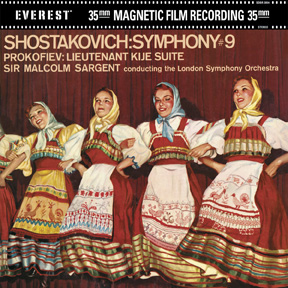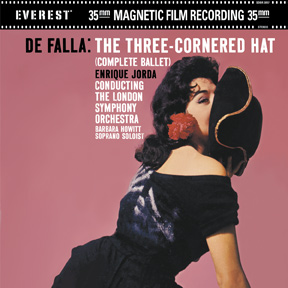|
You are reading the older HTML site
Positive Feedback
ISSUE
25
More reissues from Everest -
Shostakovitch and de Falla
Everest was a small record label which fell on hard times after a few years. Yet the recordings left behind by Everest’s first owner rank amongst some of the best recordings from the Golden Age of stereo. Not only was the music superbly recorded, but the performances by major conductors and orchestras were also superb. As an example, SBDR 3006, Vaughan Williams’ 9th Symphony with Sir Adrian Boult and the London Philharmonic Orchestra is perhaps the greatest performance of that work ever recorded. The sonics are also very good. It is a shame the master tape has been lost. If you are an Everest collector, you know that the only Everest recordings worth owning are the ones recorded and pressed while Everest was owned by its founder, Belock Instruments Corporation. After Belock, the company went through several different owners. All the subsequent owners were concerned about dollars and not sound. Thus, the sound of the magnificent Everest master tapes pressed under these later owners ranged from mediocre to bad. Hence, the only collectible Everest recordings are the original Belock pressings. Fortunately, it is very easy to tell the Belock pressings from the later pressings via the labels. Belock initially used a silver/turquoise label with the earliest of these using a wooden dowel on the outside edge of the inner sleeve just as Angel did on their earliest releases. The second and final Belock label was purple/gold with a picture of a mountain on it. The early Everest recordings can be found with either silver/turquoise or purple mountain labels. The later Belock pressings are only on the purple mountain label. Interestingly, the sound between the first and second Belock pressings of the same recording is different. The silver/turquoise pressings have more accurate timbre and tonality. The purple mountain pressings are more dynamic. Which you will prefer is a matter of personal preference. I collect both. The catalog of Belock Everest classical recordings is small—less than 100 LPs. However, the sonics and performances make the catalog very desirable for reissuing. Most the classic catalog has been released on redbook CD by Omega. Vinyl reissues have also appeared. DCC Compact Classics reissued six of the early Belock recordings including four conducted by Stokowski. Classic Records also reissued one of the early Belock recordings, SBDR 3003, Antill’s Corroboree. Classic Records has now returned to the Everest catalog and is going to reissuing 26 of the later Belock recordings—all of them originally recorded on 35mm magnetic film. The first six of this series were released in June '06 at the Stereophile Home Entertainment Show at LAX. I purchased my favorite two of these six while at the show. These were:
SBDR 3054, Shostakovitch, Symphony No. 9 and Prokofiev, Lt. Kije Suite, with Sir Malcom Sargent conducting the London Sympony Orchestra
SBDR 3057, de Falla, Three Cornered Hat Ballet, with Enrique Jorda conducting the London Symphony Orchestra. Needless to say I was very eager to hear how these reissues compared to my original purple mountain originals. After proper cleaning, I played the first three minutes of the de Falla reissue. I then played the first three minutes of my original. These two LPs are cut very different. The original is much louder. I got out my sound pressure meter and tried to match levels between the two LPs. There is about a 3dB difference between the two pressings. One of the joys of this recording is its explosive dynamics. That is why it is such a good demo record. From the hand claps of the orchestra players to the triple fortes of the orchestra, each erupts from the silence like an explosion. Very impressive on the original, not so impressive on the reissue. With the volume levels matched, I then played the reissue and the original. My listening notes recorded three main differences besides the volume. First, the reissue was quieter, the sound arose from a blacker background. Some original LPs are noisy from not using the best vinyl or from tape hiss or both. Because of this type of noise, I sometime prefer my Mercury Golden Import reissues to the original Mercury FR-1 even though the original is much more dynamic. The original Everest LP is not noisy. It is actually quite silent. However, the reissue is dead silent. The second difference noted was detail. The reissue did not have the pristine clarity of the original. I went back and did some A-B comparisons of certain passages. There was definitely a slight veiling of the sound, an obscuring of detail on the reissue. The third difference is the already mentioned dynamics. If I adjusted the volume so that the peaks maxed out at the same level between the two LPs the original LP’s quiet passages were at least 2dB down from the reissue. If I matched volumes at the soft passages, the peaks on the original LP were 2dB higher than the reissue. For whatever reason, the original appears to have a greater dynamic range than the reissue. That certainly confirms what my ears tell me. The original has explosive dynamics, while the dynamics of the reissue are quite good, but not explosive. I then turned to the Shostakovitch/Prokofiev recording. Again I had to adjust for different volumes between the two LPs. The original purple mountain label LP that I had was the one I grew up listening to. It has been played many times over the last forty six years. While there is surface noise due to the many playings, it is still a fine sounding LP. My listening notes for this pair of LPs were essentially the same as for the de Falla. Very quiet surface on the reissue. Slight veiling of the detail on the reissue. Dynamics slightly compressed on the reissue. I went back and did some comparisons with selected passages on the four LPs, listening for the degree of difference in detail and dynamics between the four LPs. My conclusion is that the reissue Shostakovitch/Prokofiev is much closer to the original SBDR 3054 than the reissue de Falla is to the original SBDR 3057. This makes me wonder if the de Falla master tape has aged less gracefully, than the Shostakovitch.Prokofiev, over the last forty six years. A lot can happen to a master tape in that time. Now the big question - if the original pressings sound better, should you buy the reissues? Well, if you have all of the originals in mint condition, probably not. I know a few people that have complete collections of the Belock pressed Everest classical recordings. These recordings were never released in great numbers like the RCAs and Mercurys. So supply is limited. However, there is not that much demand for them since they don’t appear on anyone’s Recommended List. As a consequence, in the past you have been able to pick up NM copies from dealers for US$15-30. One of the people that built a complete collection did so in less than two years, but he paid premium dollar. If you like the thrill of the chase buy the originals. They will be slightly noisier and the silver paper used on the early original covers turns brittle and deteriorates with age. The offset is that they will probably sound better. If scouring the web looking for obscure LPs is not your thing, then buy the reissues. However, if you are serious about classical music you do need to have either an original or a reissue copy of most of the Everest LPs in your collection. Most of the performances on Everest stand up very favorably with performances on RCA, EMI, Mercury and other major labels. The Jorda/de Falla reviewed here is a stirring performance. I play it more often than any of the other Three Cornered Hat recordings in my collection. The Shostakovitch 9th is another exciting performance. However, since this is the performance that was impressed on my brain as I was growing up, I may be biased. Again, it is the performance that I play when I want to listen to Shosti’s 9th. If you love classical music buy the Everests in either original (if you can find them) or reissue. Great music and great recordings. I wish all classical recordings had this combination of performance and sonics.
|


